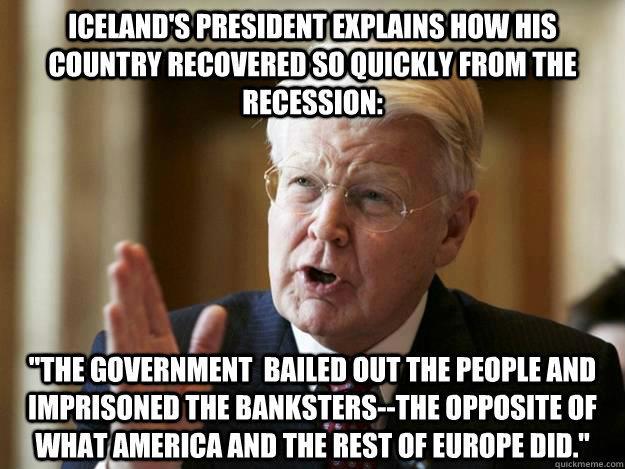Top Economists: Iceland Shows the Way — Everyone Else Is Doing It Wrong
Nobel prize winning economist Joe Stiglitz notes:
What Iceland did was right. It would have been wrong to burden future generations with the mistakes of the financial system.
Nobel prize winning economist Paul Krugman writes:
What [Iceland’s recovery] demonstrated was the … case for letting creditors of private banks gone wild eat the losses.
Krugman also says:
A funny thing happened on the way to economic Armageddon: Iceland’s very desperation made conventional behavior impossible, freeing the nation to break the rules. Where everyone else bailed out the bankers and made the public pay the price, Iceland let the banks go bust and actually expanded its social safety net. Where everyone else was fixated on trying to placate international investors, Iceland imposed temporary controls on the movement of capital to give itself room to maneuver.
Krugman is right. Letting the banks go bust – instead of perpetually bailing them out – is the right way to go.
We’ve previously noted:
Iceland told the banks to pound sand. And Iceland’s economy is doing much better than virtually all of the countries which have let the banks push them around.
Bloomberg reports:
Iceland holds some key lessons for nations trying to survive bailouts after the island’s approach to its rescue led to a “surprisingly” strong recovery, the International Monetary Fund’s mission chief to the country said.
Iceland’s commitment to its program, a decision to push losses on to bondholders instead of taxpayers and the safeguarding of a welfare system that shielded the unemployed from penury helped propel the nation from collapse toward recovery, according to the Washington-based fund.
***
Iceland refused to protect creditors in its banks, which failed in 2008 after their debts bloated to 10 times the size of the economy.
The IMF’s point about bondholders is an important one: the failure to force a haircut on the bondholders is dooming the U.S. and Europe to economic doldrums.
The IMF notes:
[The] decision not to make taxpayers liable for bank losses was right, economists say.
In other words, as IMF put it:
Key to Iceland’s recovery was [a] program [which] sought to ensure that the restructuring of the banks would not require Icelandic taxpayers to shoulder excessive private sector losses.
Icenews points out:
Experts continue to praise Iceland’s recovery success after the country’s bank bailouts of 2008.
Unlike the US and several countries in the eurozone, Iceland allowed its banking system to fail in the global economic downturn and put the burden on the industry’s creditors rather than taxpayers.
***
The rebound continues to wow officials, including International Monetary Fund chief Christine Lagarde, who recently referred to the Icelandic recovery as “impressive”. And experts continue to reiterate that European officials should look to Iceland for lessons regarding austerity measures and similar issues.
Barry Ritholtz noted last year:
Rather than bailout the banks — Iceland could not have done so even if they wanted to — they guaranteed deposits (the way our FDIC does), and let the normal capitalistic process of failure run its course.
They are now much much better for it than the countries like the US and Ireland who did not.
Bloomberg pointed out February 2011:
Unlike other nations, including the U.S. and Ireland, which injected billions of dollars of capital into their financial institutions to keep them afloat, Iceland placed its biggest lenders in receivership. It chose not to protect creditors of the country’s banks, whose assets had ballooned to $209 billion, 11 times gross domestic product.
***
“Iceland did the right thing … creditors, not the taxpayers, shouldered the losses of banks,” says Nobel laureate Joseph Stiglitz, an economics professor at Columbia University in New York. “Ireland’s done all the wrong things, on the other hand. That’s probably the worst model.”
Ireland guaranteed all the liabilities of its banks when they ran into trouble and has been injecting capital — 46 billion euros ($64 billion) so far — to prop them up. That brought the country to the brink of ruin, forcing it to accept a rescue package from the European Union in December.
***
Countries with larger banking systems can follow Iceland’s example, says Adriaan van der Knaap, a managing director at UBS AG.
“It wouldn’t upset the financial system,” says Van der Knaap, who has advised Iceland’s bank resolution committees.
***
Arni Pall Arnason, 44, Iceland’s minister of economic affairs, says the decision to make debt holders share the pain saved the country’s future.
“If we’d guaranteed all the banks’ liabilities, we’d be in the same situation as Ireland,” says Arnason, whose Social Democratic Alliance was a junior coalition partner in the Haarde government.
***
“In the beginning, banks and other financial institutions in Europe were telling us, ‘Never again will we lend to you,’” Einarsdottir says. “Then it was 10 years, then 5. Now they say they might soon be ready to lend again.”
And Iceland’s prosecution of white collar fraud played a big part in its recovery:
[The U.S. and Europe have thwarted white collar fraud investigations … let alone prosecutions.] On the other hand, Iceland has prosecuted the fraudster bank heads (and here and here) and their former prime minister, and their economy is recovering nicely … because trust is being restored in the financial system.



What's been said:
Discussions found on the web: